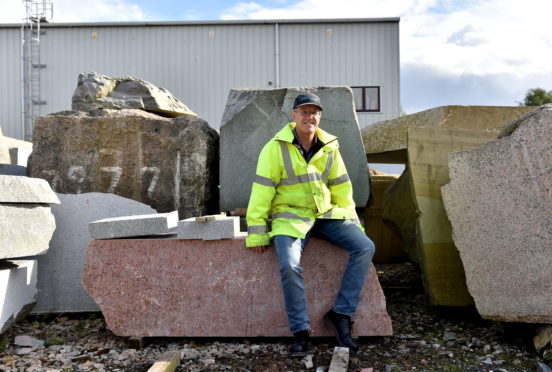It is the shining stone which has made Aberdeen synonymous with transcendent architecture.
But now, it is feared that traditional granite masonry may be a dying industry, with few employers left in business and youngsters who might have worked with the material being attracted into careers in the lucrative oil and gas industry.
This week, councillors on the city’s planning committee agreed a consultation on new policies designed to conserve the city’s granite – including setting limits on the amount of imported stone.
The local authority will also take on two apprentices as part of the Union Street Conservation Regeneration Scheme in the hope that the traditional craft can be revived to preserve the city’s fabric in the future.
And council bosses have already received expressions of interest from more than 30 young people.
Richard Collinson, commercial manager at Fyfe Glenrock in Oldmeldrum – which has more than 160 years of history working with the stone – said he was confident there could be a resurgence in youngsters taking on the skills.
He said: “I think locally, certainly until recently anyway, young people saw more opportunities to make more money in the oil and gas industry.
“(Granite) is a very hard material to work and, when guys are starting out, it can be a steep learning curve as a career choice.
“But people do tend to stick to it once they start. Maybe the downturn will lead to more young people taking up traditional skills.”
However, he was less confident the council’s policy about importing granite would lead to an upsurge in the north-east trade.
He added: “At the end of the day it is about money. Locals just can’t compete with these far eastern economies that don’t pay anything like the minimum wage.”
Planning committee member Bill Cormie said: “Having spoken about this with masons, I understand there is a real problem finding young craftsmen with the skills to work with traditional granite.
“There is a worry that work like this could die out.”
However, CARS officer Zinnie Denby-Mann is convinced the new apprenticeships could provide a “skills legacy”.
She said: “The council is planning to fund two apprentices, through a local firm of building contractors, where they will get experience of working on historic buildings.
“In addition to improving our city centre, Union Street CARS will create a skills legacy. It will ensure Aberdeen has people who are competent to carry out good repairs and renovations to our finest buildings far into the future.”
Council planning convener Marie Boulton said: “I think we are seeing a big resurgence of interest in traditional skills, particularly among young people.
“It would also help us maintain the fabric of our buildings into the future.”
Use of foreign granite to be discouraged in Aberdeen
Council chiefs will look to discourage the use of granite from the Far East, fearing it hurts both the city’s image and the climate.
The city’s planning committee met this week and agreed to put a technical advice note on materials out for consultation.
A report reads: “Aberdeen’s granite heritage is intrinsically linked to its cultural heritage and is known as ‘the Granite city’ or the ‘silver city’.
“Granite gives our city its local identity and planning policies seek to protect our heritage.
“Today Aberdeen’s granite industry has gone and while some local granite is still available it is generally used for prestige urban realm projects.
“Granite is synonymous with Aberdeen’s heritage and townscape character.
“It’s existing granite stock and heritage should be retained wherever possible, in order to preserve and continue Aberdeen’s distinct sense of place.
“While granite could be seen as an obvious material choice for new buildings in the city, it is important to note that the use of new granite, especially imported foreign stone, could actually dilute, rather than reinforce, the city’s granite heritage.”
Council bosses previously faced criticism when it emerged that granite being used in the construction of the Marischal Square development had been imported from China.
Granite provided so many different uses in the north east
Granite, fishing, paper and textiles once provided the backbone to Aberdeen’s industrial base, giving the city its trademark look.
But, since the end of the second world war, nearly all have disappeared, including extracting and working with the material for which the city is renowned.
Perhaps the most famous site was Rubislaw quarry. One of Europe’s biggest man-made holes, it opened in 1740 to support the city’s granite industry.
During the next two centuries, an estimated six million tonnes of stone were excavated for use on some of Aberdeen’s most iconic buildings.
And Rubislaw granite is found even further afield, with Waterloo Bridge in London, the terrace of the Houses of Parliament and parts of the Forth Bridge also built from the rock. The quarry closed in 1971 and is now filled with water.
Lord Provost Barney Crockett, who has studied local history, said: “Aberdonians have an intense pride in their city and take a very keen interest in its history and heritage.
“Aberdeen is not going to become a museum. I believe it is a city on the up and the uniqueness is a major selling point to both tourists and firms who are looking to set up business.”
